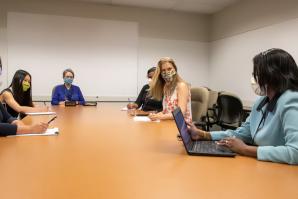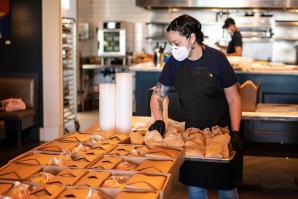From hotel rooms for people who are homeless to restaurant meals for seniors isolating for their lives, California has rapidly expanded its safety net in an attempt to catch millions of residents impacted by the coronavirus and its economic aftershocks.
In daily press conferences during the pandemic’s first months, Gov. Gavin Newsom announced new “first-in-the-nation” plans to protect vulnerable Californians from illness or financial distress at a dizzying pace.
But months in, the pandemic safety net strains and sometimes snaps under the weight of Californians’ needs. People spend hours calling agency after agency seeking help to buy groceries or pay rent. Many fall through the cracks.
Approximately 16 million Californians, or 53% of all adults, have lost income since March 13, according to estimates from a Census Bureau survey conducted in mid-June. An estimated 3.5 million residents report their family lacked enough food to eat, up from 2.7 million before the pandemic. And 3.3 million have slight or no confidence that they’ll be able to pay July’s rent.
Whether California’s safety net response represents the best the state could do to keep its residents afloat or a one-two punch of overpromising and underdelivering may lie in the eyes of the beholder.
For some of California’s biggest pandemic safety net programs, here’s how the state’s promises square with reality:
–
CalMatters.org is a nonprofit, nonpartisan media venture explaining California policies and politics. This article is part of The California Divide, a collaboration among newsrooms examining income inequity and economic survival in California.
Recommended For You

Navigating the New Flexibility
Brett Sargent, founder and CEO of True North Consulting, offers advice on Paycheck Protection Program loans
On June 5, President Donald Trump signed an extension as part of the Paycheck Protection Program Flexibility Act, allowing business owners 24 weeks, instead of eight, to use loans. Brett Sargent explains the options.

Health Officials Gear Up to Trace the Path of Coronavirus Contacts
Contact tracing has been used for decades to track the spread of infectious disease, but it was a process few in the general public understood until the highly-contagious coronavirus entered America’s consciousness in early 2020.

All in the Family
Capital Region restaurants initiate meal delivery programs to help vulnerable populations
Though restaurants are among the businesses hit hardest by the coronavirus, local restaurateurs have pooled their resources to help seniors, low-income families and others access food.

Bringing Downtown Back
Michael Ault of Downtown Sacramento Partnership talks about businesses reopening
Gov. Gavin Newsom said that “some retail, manufacturing, and logistics businesses” would be allowed to reopen beginning May 8. Comstock’s spoke with Downtown Sacramento Partnership Executive Director Michael Ault about what a limited reopening might look like in the Sacramento region.



